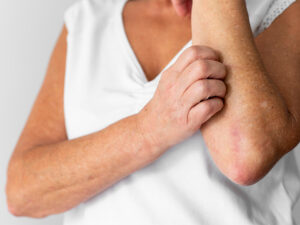
Understanding The Risk Of Mental Health Problems In Teens With Diabetes
January 3, 2022
How Can You Slow The Progression Of Chronic Kidney Disease?
January 10, 2022Diabetes impacts almost every aspect of your health and wellbeing, which is why it can be so hard to live with. Your skin is not immune to the ill effects of diabetes and all too often, problems with common skin conditions can be an early warning sign that you may have diabetes. This is because diabetes makes you more vulnerable to common skin conditions, such as bacterial or fungal infections, as well as itching and skin allergies.
Common Skin Conditions That Affect Diabetes Patients
Bacterial Skin Infections
Bacterial infections tend to occur with greater frequency in diabetes patients and can include boils, nail infections, folliculitis or infections of hair follicles, and styes that cause swelling of glands beneath the eyelids. Diabetes patients are also at greater risk of developing carbuncles, which are pus-filled bumps that form beneath the skin surface affecting underlying tissue.
Most of these skin conditions involve inflammation, which can cause the affected area of skin to be red, hot, swollen, and painful. These infections are caused by a wide range of bacteria, but the most common culprit is the Staphylococcus bacteria or staph.
In the past, such infections could pose a risk of fatality in diabetes patients, but most diabetics don’t need to worry today because of the efficacy of modern antibiotic medications and treatments to control blood sugar levels. Of course, ignoring or failing to treat diabetes and any of these skin conditions appropriately can increase your risk of more severe complications.
Fungal Skin Infections
Fungal infections are among the most common causes of skin disorders in most people and they pose an even greater risk for diabetes patients, occurring with high frequency. The most common type of fungal skin infection is linked to Candida albicans, which is responsible for yeast infections.
Yeast infections are problematic as the fungus thrives in moist warm environments and when blood sugar levels are high. The infection can affect the corners of the mouth, skin folds that are warm and moist, such as beneath the breasts, in the armpits and groins, beneath the foreskin, and also around the fingers and toes.
Common fungal skin infections that can affect diabetes patients include vaginal yeast infections, jock itch, ringworm, athlete’s foot, and oral thrush. All of these conditions cause intense itching and irritation of the area.
Localized Skin Itching

Very often, localized skin itching occurs in diabetes patients, not as a result of skin infections, but because of dry skin or impaired circulation. When linked to impaired circulation, such itching is likely to affect the lower parts of the legs to a greater extent.
This can be controlled or prevented by simply limiting the frequency of bathing, especially during winter, and by using gentle soaps, moisturizers, and skin creams after your showers.
Allergic Skin Reactions
Skin allergies tend to occur after beginning treatment as some patients may have allergic reactions to medications that are commonly used to treat diabetes, as well as to insulin. These reactions can cause rashes or even bumps at the insulin injection site. Make sure to report any symptoms to your doctor so that treatment modifications can be made accordingly.
Most skin conditions can be prevented or treated easily, but this requires better blood sugar control and awareness of skin health. Don’t ignore any symptoms of skin disease and make sure to seek treatment from your diabetes doctor promptly. In addition to the common skin conditions listed here, diabetes patients are also vulnerable to some skin disorders such as diabetic dermopathy and diabetic blisters that only affect individuals with diabetes.




